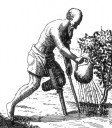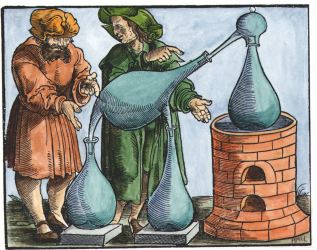| Author | Post |
|---|
Rafal T. Prinke
Member

| Joined: | Tue Mar 4th, 2008 |
| Location: | Poland |
| Posts: | 150 |
| Status: |
Offline
|
|
Posted: Mon Jun 18th, 2012 11:13 am |
|
In the 23rd Theorem of Dee's Monas hieroglyphica, which is "the most alchemical" of all those chapters, there is a short phrase in Hebrew characters (see attachement -- I am not sure how to upload it to insert inline image). My attempt at transcribing them is this (on displaying the text I see the forum engine reverses the order of the characters!):
(םרק הךשנ םשש יךימח הלמח (גומנ לעממ ךהא litroVinium וא]
but as my familiarity with Hebrew is quite limited, I would be grateful for confirmation these are correct.
Josten consulted this with Scholem for his translation of Monas and the latter said it could not be translated and possibly was a cabbalistic riddle "which remains unsolved", but that it seems to referer to a chemical process.
Has anyone published a solution or discussion of that phrase? I can't find anything on it in the books/articles of the leading Dee scholars.
In Hamilton-Jones' (inferior) translation this fragment is rendered as "an incorruptible salt by which the first principle of all things is preserved, or better, that the substance which floats within the vitriol after its dissolution, shows the apprentice a primordial but very transitory specimen of our work".Attached Image (viewed 563 times):
 Last edited on Mon Jun 18th, 2012 12:32 pm by Rafal T. Prinke
|
Rafal T. Prinke
Member

| Joined: | Tue Mar 4th, 2008 |
| Location: | Poland |
| Posts: | 150 |
| Status: |
Offline
|
|
Posted: Mon Jun 18th, 2012 12:32 pm |
|
| Just to be sure -- I am attaching an image of my transcription in the correct order of characters. Attached Image (viewed 552 times):
 Last edited on Mon Jun 18th, 2012 12:38 pm by Rafal T. Prinke
|
Paul Ferguson
Member

| Joined: | Fri Feb 15th, 2008 |
| Location: | |
| Posts: | 1538 |
| Status: |
Offline
|
|
Posted: Mon Jun 18th, 2012 10:12 pm |
|
There is a reference here at footnote 27.2, which does not shed much light:
http://books.google.com/books?id=MwBNel_aX0wC&pg=PA226&dq=dee+%22litro+vinium%22&hl=fr&sa=X&ei=2pbfT7qgOeLK0QXUp-nVCg&ved=0CDQQ6AEwAA#v=onepage&q=dee%20%22litro%20vinium%22&f=false
I think the phrase is Aramaic written in Hebrew characters.
|
Rafal T. Prinke
Member

| Joined: | Tue Mar 4th, 2008 |
| Location: | Poland |
| Posts: | 150 |
| Status: |
Offline
|
|
Posted: Tue Jun 19th, 2012 07:46 am |
|
Thank you, Paul. The note by David Ovason you have found seems to confirm that no one had tried to solve that riddle.
I think the phrase is Aramaic written in Hebrew characters.
Interesting. And is my transcription correct? I am not sure I properly identified all characters.
|
Paul Ferguson
Member

| Joined: | Fri Feb 15th, 2008 |
| Location: | |
| Posts: | 1538 |
| Status: |
Offline
|
|
Posted: Tue Jun 19th, 2012 07:29 pm |
|
Rafal T. Prinke wrote:
Thank you, Paul. The note by David Ovason you have found seems to confirm that no one had tried to solve that riddle.
I think the phrase is Aramaic written in Hebrew characters.
Interesting. And is my transcription correct? I am not sure I properly identified all characters.
Seems ok to me.
That it's Aramaic seems to be confirmed by the fact that one word I can identify, the second word in the second line, which seems to be 'memeyl', means a 'crushing-press for olives' in the Targums, which seems to fit into the context quite nicely.
If someone would like to use Jastrow to wrestle with the rest of the text then we might see wonders. Anyone like some homework?
http://www.tyndalearchive.com/tabs/jastrow/Last edited on Tue Jun 19th, 2012 07:29 pm by Paul Ferguson
|
Rafal T. Prinke
Member

| Joined: | Tue Mar 4th, 2008 |
| Location: | Poland |
| Posts: | 150 |
| Status: |
Offline
|
|
Posted: Tue Jun 19th, 2012 09:12 pm |
|
| Jastrow seems to be a great reference but my grasp of Hebrew/Aramaic is not good enough to use it. I have found what seems to be the first word on the far right: AV. It is apparently a definite article (the) or a contraction of "he, that, this". But does not make much sense to me with the "litro Vinium".
|
Paul Ferguson
Member

| Joined: | Fri Feb 15th, 2008 |
| Location: | |
| Posts: | 1538 |
| Status: |
Offline
|
|
Posted: Tue Jun 19th, 2012 09:56 pm |
|
Does anyone have access to a copy of Lloyd-Jones's work on the discovery of Hebrew in Tudor England? It contains a list of those Aramaic books that Dee owned and those which university booksellers of the time might stock, though I suspect that most were grammars or dictionaries. Might shed some light:
http://books.google.com/books?id=nRKUNkeFFJMC&pg=PA20&dq=%22john+dee%22+aramaic&hl=fr&sa=X&ei=XebgT4-dEcnn8QOr1Z2UDw&ved=0CEcQ6AEwBDgU#v=onepage&q=%22john%20dee%22%20aramaic&f=falseLast edited on Tue Jun 19th, 2012 10:48 pm by Paul Ferguson
|
Paul Ferguson
Member

| Joined: | Fri Feb 15th, 2008 |
| Location: | |
| Posts: | 1538 |
| Status: |
Offline
|
|
Posted: Tue Jun 19th, 2012 10:48 pm |
|
Rafal T. Prinke wrote:
Thank you, Paul. The note by David Ovason you have found seems to confirm that no one had tried to solve that riddle.
I do not entirely agree with Ovason's comment regarding 'litrum'. Although I agree with him that the word cannot mean 'litre' (or 'liter') in the modern sense, as this unit of measurement had not yet been invented, a 'litron' was a unit of dry measurement in use in France from (I think) the late sixteenth century (i.e. Dee's time) and one Latin form of that word seems to have been 'litrum':
http://books.google.com/books?id=jz_rEi4zSNMC&pg=PA799&dq=%22litron%22+litrum&hl=fr&sa=X&ei=NPDgT7WULcri8AOhp6GVDw&ved=0CFQQ6AEwBQ#v=onepage&q=%22litron%22%20litrum&f=false
|
Paul Ferguson
Member

| Joined: | Fri Feb 15th, 2008 |
| Location: | |
| Posts: | 1538 |
| Status: |
Offline
|
|
Posted: Thu Jul 12th, 2012 01:25 am |
|
Rafal T. Prinke wrote:
Jastrow seems to be a great reference but my grasp of Hebrew/Aramaic is not good enough to use it. I have found what seems to be the first word on the far right: AV. It is apparently a definite article (the) or a contraction of "he, that, this". But does not make much sense to me with the "litro Vinium".
I am very reluctant to let this one rest. When time allows I will have a go at the Aramaic(?).
|
Paul Ferguson
Member

| Joined: | Fri Feb 15th, 2008 |
| Location: | |
| Posts: | 1538 |
| Status: |
Offline
|
|
Posted: Tue Oct 2nd, 2012 10:03 pm |
|
I started a little thread about this on a language forum:
http://forum.wordreference.com/showthread.php?t=2500435
My Aramaic theory seems to be a blind alley and it's not Hebrew either.
If it's a straightforward substitution code and we are meant to read it from left to right then we run up against the double letters at the ends of words which almost certainly means the underlying langage is not Latin (where double letters at the ends of words are almost unheard of except in numerals like CCXX). So, English?
If it *is* Latin then I suppose חמיךי could be read (from right to left) as 'chymici' or 'chemici' ('of the alchemist') and קרם as 'quorum' ('of which').
I refuse to accept that it's just nonsense. I will keep trying to decipher it.
|

Current time is 09:40 am | |
|

